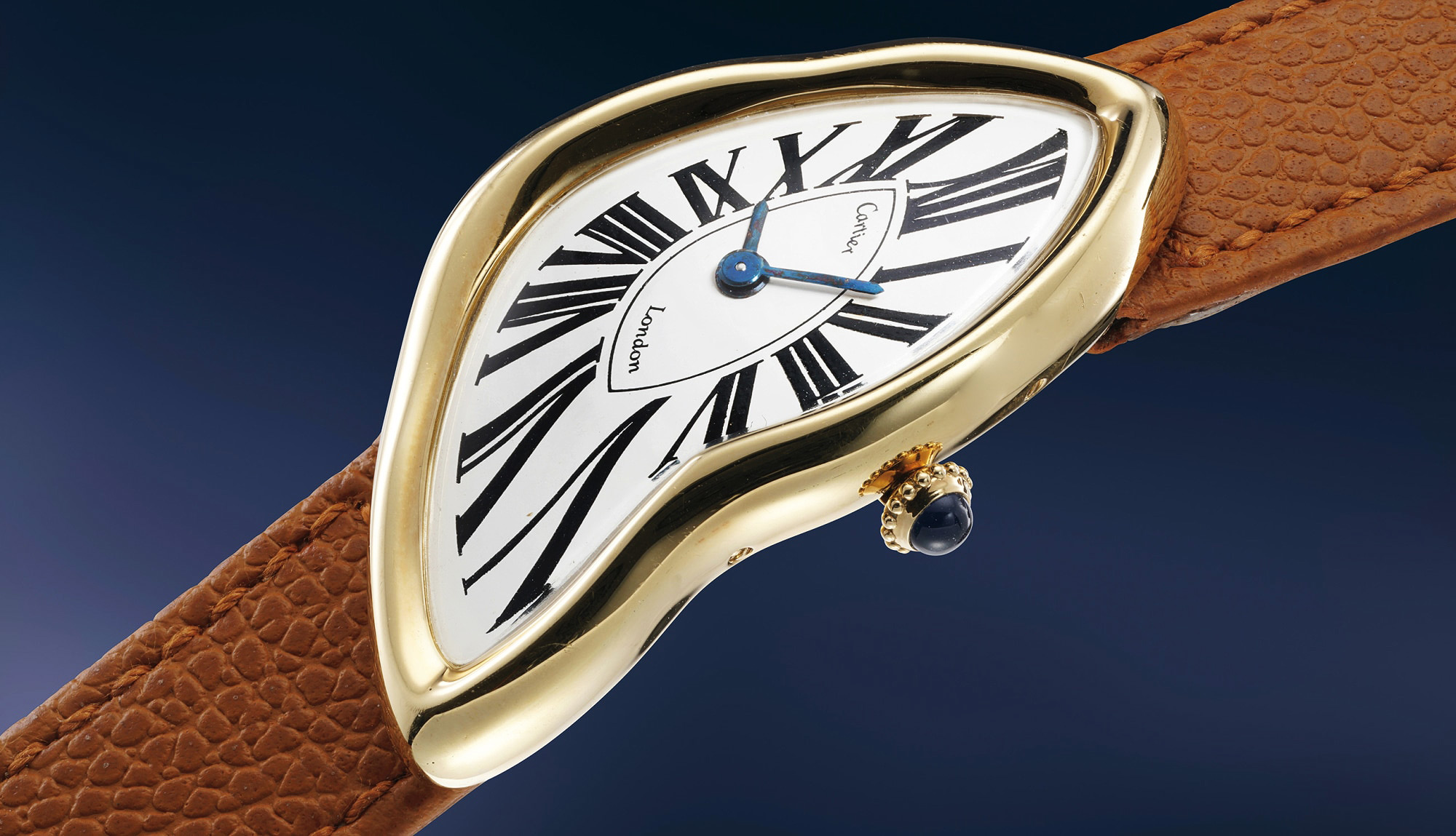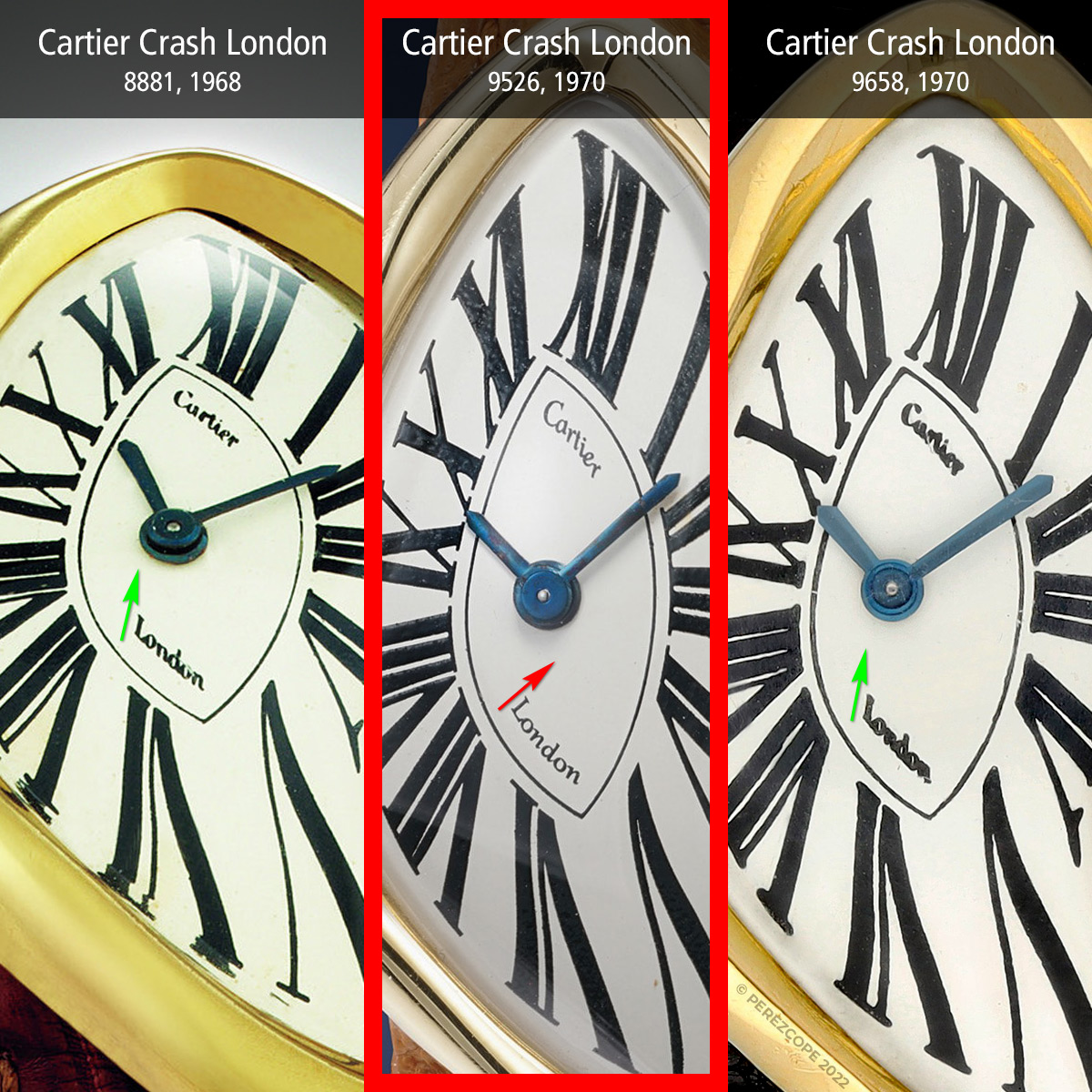Leading auction house Phillips is offering a super rare 1970 Cartier Crash London at their New York Watch Auction SEVEN that will take place from December 10 – 11, 2022. An absolutely stunning piece at first glance, the Crash features a very unusual dial that could be far from “clean and original” as claimed by Phillips. Then there are some serious issues with the case, and if that was not enough, it appears Phillips made-up their own story about the provenance from the original owner. Before it was consigned to Phillips, the watch made its rounds in auction house circles but the story the owners told was a different one, namely that the Crash was bought at auction in the early 1990s. Beware! What is described as a “wonderful example for the elite collector” could be Crash Trash after all.
.
Lot 9: Cartier Crash London, 9526, 1970
The Cartier Crash has become an extremely coveted timepiece. Earliest examples which were made on special request by Cartier in London regularly fetch insane sums at auction. Just recently, a well-preserved example from 1967/68 sold for USD 1.5 million at the emerging online auction house “Loupe This”. Phillips’ example is from 1970/71 and as can be seen in the picture below, the watch is a gorgeous piece of art, at least at first glance.

Auction link: Lot 9 – Cartier Crash London, 9526, 1970 (Phillips)
The first thing to notice is that the crown of the Phillips’ Crash (below, center) is not consistent with other examples from the same era. This could of course be some weird service part but there is no mentioning of this crucial detail, neither in Phillips’ description nor in the condition report.

At first glance, the crown appears to be a later part. See that little “neck” at the bottom the arrow points at? On later Crash watches from the 1990s, the stem tube had a larger diameter. It is possible that the crown “neck” is meant to go into the tube. However, the exact same crown could not be found.

Compared to what you are about to see, the crown is a relatively minor issue.
.
Unusual Dial
As mentioned in the introduction, the dial of Phillips’ Crash London is very unusual, actually unseen. Phillips states:
“…stunning original dial..” and “The dial is clean and original.”
A comparison with watches in close case number proximity, however, brings considerable discrepancies to light. While usual dials are quite rough and feature lots of imperfections, the dial in question is almost too perfect.

Everything seems too sharp, especially the serifes of the Roman numerals. In addition, the Cartier London print features a completely different typeface and the alignment is odd.
A closer look at the Roman numeral “XII” at 12 o’clock reveals more unusual details. The left diagonal stroke of the “X” does not follow the pattern of other dials. The intersection between the two diagonals is very odd.

There are more discrepancies. For instance the bottom of the “V” in “VI”, “VII” and “VIII” is not on a typographical baseline with the rest of the Roman numerals.

The back of the dial bears some interesting details too. Compared to a much later London Crash from 1989/90, the surface looks like new and is almost glossy, even to the extent of reflecting the movement. On the later dial, the surface has the patina one would expect from an original vintage dial.

The question is, was the dial refreshed prior to the auction or is there another reason for the lack of patina? The above comparison also shows how the very same Jeager LeCoultre caliber was still used in later versions of the London Crash, although with Cartier engravings. Speaking of movement, has anybody else noticed that the Crash London at Phillips has an American import code on the balance cock? Come again? An American import code on a London Crash?
.
Imported Movement
Besides the strange dial, the movement bearing an American import code is the next big question mark. Anybody with a little bit of knowledge in this field knows the codes were discontinued in the late 1960s. American import codes for Swiss watch movements were introduced in 1936 to fight widespread smuggling of Swiss movements. The codes consist of three letters, typically engraved on the balance cock, and were assigned by the U.S. Treasury to the various American importers of Swiss watch brands. “VXN”, the code found on this movement, refers to the U.S. importer of Vacheron & Constantin and LeCoultre. When exactly were these codes discontinued? I checked with the Omega museum as Omega happens to have some of the most accurate archives in the industry. One of the last batches of movements destined to the American market still bearing the “OXG” import code on the balance cock was produced on October 10, 1968 and delivered to the U.S. on October 24, 1968. Basically, by late 1968, the import codes were definitely no longer required in the wake of new trade agreements.

Now, the gold case bearing the date letter “p” which suggests the watch was produced between June 1970 to May 1971. The one million dollar question is, why would the movement of a London Crash made in that time frame, even if specifically produced to be imported to the United States (which is unheard of), feature an American import code, more than a year after the codes were discontinued? This is very peculiar to say the least. Another unusual detail is the “Swiss Movement” designation engraved on the back of the case which seems to be wanting to hint at the illogical imported movement. Alright, so far we have a strange crown, an unusual dial and an odd movement that makes little to no sense. Is there more? You bet!
As a side-note, identical LeCoultre calibers with “VXN” import code can be bought on eBay for less than 100 bucks.
.
Case
The case of Phillips’ London Crash has a number of features that differ from known examples in close case number proximity, most notably the four holes around the cavity for the movement. As you can see in the following comparison, other cases from the early series lack these holes.

A closer look a the case finish reveals considerable differences. The case of 9526 has an even vertical satin finish while the other cases appear to have been sanded in a rather rough manner with no discernible direction. The finish inside the movement cavity is granular but the other cases have either perlage finish or were sanded in similar rough fashion as the top of case.
Coming back to the holes around the cavity, interestingly, cases with similar holes can be found in later London Crash series from the late 1980s.

Strange crown, unusual dial, odd movement, weird case. What else? Let’s have a closer look at the hallmarks, shall we?
London Hallmarks
The first thing that catches the eye in the comparison below is the “sandy” surface finish of the Phillips watch. To the best of my knowledge, no other London Crash has this finish. This kind of surface is typically the result of sand casting. What is really strange though is that the very same surface can be found within the hallmarks. This is an indication that the hallmarks were cast as well. But, hallmarks are always stamped, never cast, and in the case of London hallmarks, they are applied by the London Assay Office.

If the hallmarks were indeed cast, the case would undoubtedly be fake. Let’s look at this in more detail. The next comparison shows that the spacing between the symbols varies in the Phillips watch. This should not be the case as all four punches are part of the same tool. In addition, the hallmarks appear to be too deep.

The following picture shows what official hallmark punches look like.

Let’s recapitulate: Strange crown, unusual dial, odd movement, weird case that resembles much later cases, and very peculiar hallmarks that look cast rather than stamped. At this point, is there any doubt that something is terribly rotten in the state of New York?
.
Thoughts
With so many red flags, one cannot but wonder how such a watch can end up as one of the main acts at Phillip’s New York auction that marks the grand finale of their auction year. I was told that super scholar John Goldberger himself waved this watch through. Really? With more than 40 years of experience in this field, how is it possible he could miss what I was able to put together in a couple of weeks? Cartier watches were very popular in the 1990s. What happened is that the very artisans who produced the watches for Cartier London, went on to manufacture countless fakes to satisfy the insatiable demand. For this reason, early Cartiers need to be inspected meticulously. Then, there is this other thing. Before being consigned to Phillips, the watch was offered to a number of other major auction houses. They said independently from each other that the family of Daphne Farago disclosed the watch was bought at auction in the early 1990s. Phillips, however, claims Daphne Farago was the original owner:
“Phillips is extremely honored to offer the present, original Cartier London Crash, directly from the family of the original owner.”
Unfortunately, I do not have all the old auction catalogues to do a proper search but I would love to get to the bottom of it. If there is someone out there willing to help solve this mystery, please join the effort. The most important thing right now is to make sure nobody gets burned with this questionable watch. I am pretty sure Phillips already groomed possible buyers and I have no illusions that the mainstream watch media will pick up the story and help spread the word as they are corrupt to the core and care more about being in good graces with watch brands and auction houses than to protect collectors and possible victims of fraud. So, once again it is up to us passionate watch enthusiasts to disseminate this information until it hopefully reaches every last corner of the internet. Let’s do this!
Thank you for your interest.

You make watch collecting, trading and reading an absolute treat! I enjoy every article of yours. Keep up the good work please.
LikeLike
Simply, Wow!
This appears to be “fugazi” on a whole new level. Okay, maybe not since fakers are constantly reaching for new heights! Your reporting is ALWAYS a joy to read and a constant reminder to STEER CLEAR of the “hot item” vintage market (not that I have the budget to dabble).
What says Cartier “guru” Mr. Cramer about this? Somehow I imagine this lot will be “suddenly” pulled just before auction.
Thanks for your continued diligence, Jose!
LikeLike
Additionally, I think the biggest red lights would be the “X” in the “XII” and the way the “Cartier” on the dial looks like a perfectly arranged “stair steps” configuration BUT the “London” is aligned uniformly along the oval separating it from the romans…two totally different arrangement styles.
LikeLike
Love your work.
LikeLike
Another great article, you can only hope that the rich who buy these watches will take head, but suspect they care more about image and buying at so called reputable auction houses than their wealth. As the saying goes, ”a fool and his money are easily parted”!
LikeLike
Maybe I’m being unusually conciliatory here, but I truly think sometimes these people are just ignorant. I’m not convinced they’re all scammers, although certainly that could be the case.
LikeLike
Great article!
LikeLike
Great
LikeLike